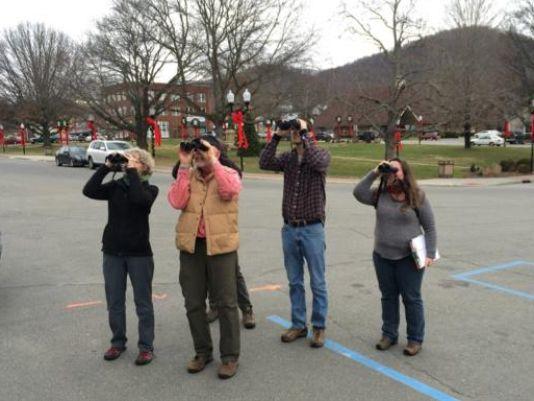The article originally appeared in Black Mountain News.
The annual National Audubon Society Christmas Bird Count now underway throughout North Carolina is not a new event for bird lovers. It is celebrating its 116th birthday.
You can’t submit individual reports for the Christmas Bird Count (you must be registered with an official group of bird counters). But you can take part in the Great Backyard Bird Count in February, which you can do in your back yard in as little as 15 minutes (more about this in the second half of this article).
Doug Johnston, one of the area count leaders and compilers for the Christmas Bird Count said it was organized initially as an alternative to the “side hunt,” a popular event at the turn of the 20th Century in which sides competed to see how many birds they could kill.

Christmas Bird Counts are counts of a totally different nature, constructed so that researches can make scientific inferences from the data gathered. Each count is done within a 15-mile radius of a certain point, Johnston said. Each circle may be divided into
The annual Christmas Bird Count is part of the Audubon Society’s 116-year tradition of citizen science. It collects data that helps shape the future of birds and climate science nationwide. For years, North Carolina has ranked among the top performing states in the event. During last year’s count, the state’s 51 participating geographic circles tallied the the highest number of 15 endangered species among states with circles participating.
Audubon’s annual bird count relies on some 72,000 volunteer bird counters in more than 2,400 locations in the Western Hemisphere, its website states. Data collected in North Carolina will count every bird and bird species spotted within a specific area. The volunteers make up a huge citizen science network that continues the tradition of the Audubon Christmas Bird Count stretching back more than 100 years.
Heather Hahn, executive director of Audubon North Carolina, said the Christmas Bird Count provides valuable information about climate change and its effects on N.C. birds. The data collected will be used to influence local lawmakers to enact legislation to protect the state’s birds and communities in the future, she said.
“This is an exciting time of year for birders to get outside and engage in citizen science,” Mary Alice Holley, a media relations consultant for state Audubon Society office, said in an email. “This year, 52 count circles will be hosted across the state, giving participants even more opportunities to get involved in the global event.”
James Poling, a local resident and experienced bird counter and naturalist, has participated in the Christmas Bird Count since 2010. He has also joined bird counts conducted for Buncombe County, Black Balsam and Rutherford County.
“Much research has emerged from the data collected during the Christmas Bird Count that helps us understand birds and the larger changes in the environment that helps us as human as well as other animals and plants,” he said in an email.
Poling said a typical bird counting day starts when the sun comes up and continues until the sun goes down - about nine hours in December.
“Some groups continue after dark to listen for owls that can be added to the count,” he said. “We count not only species but also individual birds. So the final tally for the county is a sampling of the species and individuals living in our area in the two weeks around Christmas.
Poling especially enjoys counting birds in the Asheville Watershed (having gotten permission). He’s seen bald eagles and red-breasted merganswers. At Lake Rockmont, he’s seen a brown creeper. Near Lake Lure, he’s seen a northern harrier hawk. He’s seen wood storks flying over Black Mountain.
“I enjoy the camaraderie of spending the day with other birders, braving the sometimes cold weather,” he said, “and the feeling of accomplishment that I am contributing to our knowledge of birds and the science of environmental studies.”
If you are interested in the Christmas Bird Count now underway, visit christmasbirdcount.org, and contact Tom Tribble at tntribble@gmail.com. Or call 253-7994, or contact Doug Johnston at wellsteadwest@gmail. com.
The Great Backyard Bird Count also helps expand the understanding of birds. Running from Feb. 12-15, it engages bird watchers of all ages in counting birds to create a real-time snapshot of bird populations. You may count for 15 minutes or as long as you wish during one or more days of the four-day event, then report your sightings at birdcount.org. You can participate from your backyard or anywhere in the world.
The checklists submitted by each bird counter help professional organizations learn more about how birds are doing and how better to protect them and their habitats. Last year, some 140,000 participants submitted their observations online.
Lyndall Noyes-Brownell, a local resident, is excited about participating in the GBBC this year. She is already taking pictures of the birds that visit her feeders.
“The information from GBBC participants, combined with other surveys, helps scientists learn how birds are affected by environmental changes,” she said in an email. “The information sent can provide the first sign that individual species may be increasing or declining from year to year.
“Data gathered over many years help highlight how a species’ range may be expanding or shrinking. A big change, noted consistently over a period of years, is an indication that something is happening in the environment that is affecting the birds and that should receive attention.
“GBBC information also allows us to look at what kinds of birds inhabit different areas such as cities and suburbs compared to more natural habitats.”



